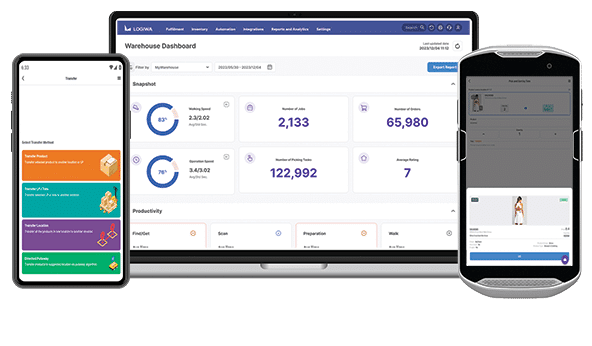Multi-channel fulfillment involves offering the same product via multiple sales channels. The sales channels may include online and offline platforms, such as your website, mobile app, social media, brick-and-mortar outlets, and third-party stores.
Multi-channel fulfillment offers many benefits, such as boosted sales, improved order fulfillment, and an enhanced customer experience. However, you can’t be successful with multi-channel ecommerce without an effective warehouse management system (WMS).
A WMS enables you to unify and efficiently manage fulfilling orders from different channels. Keep reading to discover more about the benefits of multi-channel fulfillment and how to execute it successfully with a WMS.
But first, here are the key takeaways from this multi-channel fulfillment guide:
- Multi-channel fulfillment can help you reach more customers and optimize the shopping experience across your various platforms.
- A warehouse management system (WMS) aids multi-channel fulfillment by providing real-time visibility of orders from all channels and warehouse processes to fulfill orders.
- Automating multi-channel fulfillment processes with a WMS can reduce manual tasks, labor costs, and human errors within your warehouse.
- Multi-channel fulfillment processes you can automate with a WMS include inventory management, order splitting and routing, rate shopping, and more.
- Logiwa WMS offers 200+ out-of-the-box integrations you can use to easily connect all of your sales channels to your warehouse.
In this guide, we’ll discuss:
What You Need for Successful Multi-Channel Fulfillment
At a glance, executing and managing multi-channel fulfillment may appear complex. However, thanks to technological advances in the logistics and warehousing industries, you can easily implement multi-channel ecommerce management.
Below is everything you need to successfully streamline and manage multi-channel fulfillment and gain a competitive advantage.
Integrations
The first thing you need is a warehouse management system that can integrate with ecommerce channels, warehouses, and shipping partners. With integrations, you can use your WMS to monitor, track, and process sales on all platforms selling your products.
You can also monitor inventory levels and order fulfillment within the warehouses carrying your products. We recommend choosing a WMS that integrates with popular ecommerce channels, such as Shopify, Amazon, WooCommerce, Walmart, and so on.
Otherwise, you’ll have to set up the integrations manually. This is far from cost-effective because the time-to-value is longer and the integrations may not function as expected.
Complex Order Routing Capabilities
Businesses use complex order routing capabilities to manage and direct orders from multiple sales channels to the most appropriate fulfillment centers or warehouses. It’s essential for optimizing shipping in multi-channel ecommerce management.
For example, if a customer orders your product from Amazon or social media, you should ship the order from an optimal fulfillment location. The most suitable fulfillment location is the one that’s closest to the customer and capable of completing the order the fastest and cheapest.
Having complex order routing capabilities is again valuable if you must split and fulfill an order from multiple locations. Order splitting becomes necessary when different order items must come from different warehouses. The feature will enable you to split the order and route each item to the relevant fulfillment center, preventing delivery delays.
In summary, complex order routing capabilities simplify fulfilling orders with the most cost-effective and efficient shipping method.
Automation Rules
With the right automation rules, you can provide a seamless shopping experience across various platforms while practicing multi-channel fulfillment. Customers can order from any of your sales channels, and your automated system will process the order from start to finish. Such a setup makes your warehouse more efficient and productive.
Also, automating warehouse processes, such as inventory retrieval, payment processing, order routing, and boxing, speeds up order processing to improve customer satisfaction.
Real-Time Visibility
You can’t practice multi-channel fulfillment without having real-time, end-to-end visibility. This visibility gives you a bird’s-eye view of orders, inventory levels, shipping statuses, and more across warehouses and fulfillment centers. Without such insights, multi-channel ecommerce management will involve a lot of guesswork, which is ineffective.
Fortunately, with a complete WMS like Logiwa, you can monitor and track your warehouse, fulfillment centers, ecommerce channels, logistics partners, and more from one device. Real-time updates provided by the WMS will help you make well-informed, data-driven decisions that keep your facility running smoothly.

The Benefits of Using Logiwa WMS for Multi-Channel Fulfillment
Whether you’re an omnichannel or multi-channel fulfillment business, you need a warehouse management system. If you want one that can scale with your business or that you can easily adapt to your needs, you can’t go wrong with Logiwa WMS. Let’s dive further into why.
1. Improves Inventory Visibility & Management
Logiwa WMS simplifies getting a handle on everything happening within your warehouse, including incoming and outgoing inventory, workers, equipment, and more. Knowing the state of everything in your warehouse makes it possible to identify and fix shortcomings to optimize operations.
For example, Logiwa shows real-time inventory levels and even forecasts inventory and demand so you can avoid overstocking or understocking. You can even tie inventory to different channels in your multi-channel ecommerce setup. Doing so can eliminate mistakes, such as allocating stock to the wrong channel, and other consequences that negatively affect customer satisfaction and your bottom line.
2. Reduces Manual Tasks
A large percentage of warehouse fulfillment costs go to labor. Minimizing manual tasks can help you save money, speed up processes, and reduce the risk of costly human errors. With Logiwa WMS, you can automate several tasks and processes across your warehouse to reduce your need for human labor.
For example, you can integrate robotic systems with the WMS to assign machines to pick, sort, and pack orders. You can also automate inventory management, label printing, and several other small tasks to make your facility run faster and smoother.
Using Logiwa WMS to automate tasks across your multi-channel fulfillment setup will optimize your operations and minimize expenses.
3. Enables Seamless Integrations Across Your Tech Stack
Logiwa WMS does not operate in a vacuum. Connect your entire warehouse tech stack to the WMS to get a holistic view of your facility’s operations. Even better, connecting your tech stack to the WMS is a breeze since the system comes with 200+ integrations built in.
These integrations include options for ecommerce, logistics, robotics, accounting, and ERP systems that 3PL, B2B, and DTC warehouses typically use.
4. Saves Money
Besides saving money by reducing labor costs and human error through automation, Logiwa helps you save money in other ways.
For example, Logiwa WMS offers rate shopping options built right into the software. Through this capability, you can scan available shipping partners to find the one with the lowest shipping fees and fastest delivery times. Shipping with the most affordable logistics company lets you transfer the cost savings to customers.
Multi-Channel Fulfillment Processes You Can Automate With a WMS
Our WMS ensures there are no limits to how much you can automate your warehouse and fulfillment centers. Below are just some of the multi-channel fulfillment processes you can automate with Logiwa WMS:
- Order routing and order splitting: Order routing involves identifying the most appropriate fulfillment center or location to fulfill a customer’s order. On the other hand, order splitting requires dividing a customer’s order into multiple shipments and fulfilling each order from different locations. Manually splitting or routing an order can be time-consuming and ineffective. However, a WMS can automate the process and use real-time data to deliver the best results.
- Inventory management: While a WMS can help you keep an eye on inventory, besides monitoring inventory levels, you can use a WMS to automate inventory storage, retrieval, and restocking. Automating storage can help maximize storage space and prevent misplaced inventory.
Order status updates: Customers want to know the status and ETA of orders. Logiwa WMS can track orders in real time and automatically deliver status updates to customers. - New item creation: A customer may order an item currently unlisted in the warehouse’s inventory. If this occurs, the WMS can automatically create a new item record for the missing item and fulfill the order.
- Address correction: A customer may place an order and provide the wrong shipping address. If this happens, the WMS can automatically validate the address and correct errors with the help of an integrated address verification service.
- Listing correction: A WMS can perform inventory checks to identify items that are available in the warehouse but unlisted on the online store. After automatically identifying discrepancies, the system can fix them by creating new listings on the online store.
- Fulfillment rules: Logiwa can adapt fulfillment rules to ensure each order completes with the most effective processing and shipping routes.
Logiwa WMS vs. Other WMS Providers
Why should you choose Logiwa WMS over other WMS providers? First, connecting Logiwa WMS to your existing tech stack is easy and fast. Thanks to the integrations pre-packaged with the WMS, you can connect to multiple channels quickly, speeding up onboarding. All you have to do is plug in the API keys to connect your desired systems, and you’re good to go.
Logiwa WMS is also highly configurable, meaning you can adapt it to your warehouse’s unique needs. Adapting the software is super simple, requiring no coding skills. All you have to do is change the settings to match your requirements. Changes you can implement include everything from selecting picking and packing algorithms to optimizing order routing.
Logiwa’s reporting and analytics feature provides a comprehensive view of your warehouse’s performance. The system generates detailed reports and analytics that provide insight into order fulfillment, inventory accuracy, automation, and more. With these insights, you can identify and fix inefficiencies and make data-driven decisions to improve performance and customer service.
Lastly, since Logiwa is a cloud-based WMS, you can access it remotely via mobile apps. Plus, the platform can easily scale to keep up with your changing business needs.
Streamline Your Fulfillment Operations With Logiwa WMS
With multi-channel fulfillment, you can reach a wider customer base and provide a seamless shopping experience across various platforms. However, implementing and making the most of multi-channel fulfillment is only possible if you have the right WMS.
Logiwa WMS is fully configurable and ready to help you automate warehouse processes across your facilities. Everything you need to integrate all of your systems and channels is available right out of the box. Ready to get started? Request a demo of Logiwa WMS today!
Grow your 3PL fulfillment business – without additional headcount.
Warehouse Management
Modern digital WMS powers a modern fulfillment experience






